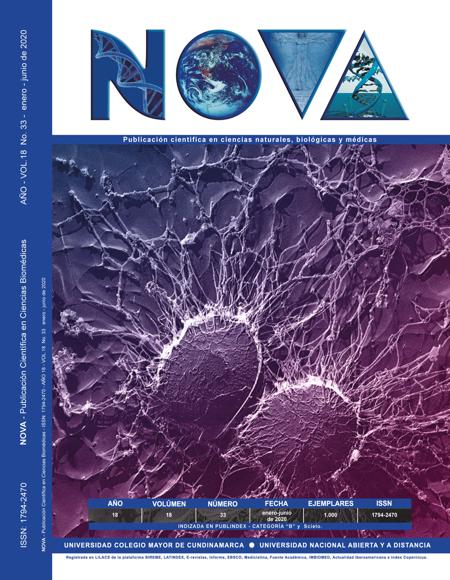Physical principles - chemicals of colors used in microbiology
Principios fisico – químicos de los colorantes utilizados en microbiología
Show authors biography
The use of dyes in the identification processes in microbiology is based on the physicochemical properties of these substances. In the field of physics, optics explains how all objects are observable depending on the wavelengths that are absorbed and transmitted within the so-called "visible spectrum", these transitions are, in turn, due to chemical compounds and the electronic movements within atoms. Likewise, when a dye interacts with a cell or tissue, reactions occur that depend on functional chemical groups called chromophores and auxochromes.
Depending on the chemical compounds that constitute them, the dyes can be acidic, basic or neutral and this connotation is due to the active part of the dye and the reaction it causes on the microbial cells.
On the other hand, stains in microbiology can be simple or differential, depending on whether the entire sample is stained with one or more dyes. In the first case is the example of the lactophenol blue staining and in the second, the Gram staining.
This article describes the main colorations used in microbiology and explains the physical and chemical foundations of these processes.
Article visits 3195 | PDF visits 1144
Downloads
1. Decré D, Barbut F, Petit JC. Role of the microbiology laboratory in the diagnosis of nosocomial diarrhea. Pathol Biol (París). 2000; 48: 733-744.
2. Retamales Castelletto E y Manzo Garay V. Recomendaciones para la tinción de
frotis sanguíneos para la lectura del hemograma. Instituto de Salud Pública departamento Laboratorio Biomédico Nacional y de Referencia. Instituto de Salud Pública de Chile., (Chile). 2015. Dispónible en: http://www.ispch.cl/sites/default/files/RECOMENDACIONES%20PARA%20LA%20TINCI%C3%93N%20DEL%20FROTIS%20SANGU%C3%8DNEO.pdf. Consultado 20 de febrero de 2019.
3. Madison BM. Application of stains in clinical microbiology. Biotech Histochem. 2001; 76: 119-125.
4. Capilla Pérea P. Fundamentos de colorimetría. En: Tecnología del color. Universitat de València, Servei de Publicacions. 2002. 15-25.
5. D. Alonso Cerrón-Infantes* y Miriam M. Unterlass* Ecofriendly synthesis of colorants. Revista de Química PUCP, 2018, vol. 32, nº 1
6. Flores B, E., Roque P, C., Ochoa L, R. Química del color, Revista de Química. Vol. IX. N° 2. diciembre de 1995 p 99-109.
7. Rivera Rojas L., Fundamentos de Química aplicados a las ciencias de la salud. Bogotá: Ediciones Unisalle., 2018.
8. Fesenden, R. Fesenden, J. Química Orgánica. 2da Edición. Grupo editorial Iberoamérica; 1983.
9. McMurry, J. Química Orgánica. 7ma edición. Cengage Learning Editores, S.A. México. 2008.
10. Magdalena M. La Química y los Colorantes en “El carbono y sus compuestos” publicación del Instituto Tecnológico de Estudios Superiores de Monterrey. 2009. Disponible en: http://www.academia.edu/1844623/La_Qu%C3%ADmica_Org%C3%A1nica_y_los_Colorantes. Consultado 20 de febrero de 2019.
11. Penney DP, Powers JM, Frank M, Churukian C (2002) analysis and testing of Biological Stains - the Biological Stain Commission Procedures. Biotechnic & Histochemistry 77: 237-275
12. Vázquez, C. Martín, A. de Silóniz, MI. Serrano, S. Técnicas básicas de Microbiología Observación de bacterias. Reduca (Biología). Serie Microbiología. 3 (5): 15-38, 2010.
13. Piña Mondragón, S. Decoloración biológica del colorante azul directo 2 en un filtro anaerobio/aerobio. T E S I S de grado, PROGRAMA DE MAESTRÍA Y DOCTORADO EN INGENIERÍA, UNIVERSIDAD NACIONAL AUTÓNOMA DE MÉXICO. P. 9 -12. 2007. Disponible en http://www.ptolomeo.unam.mx:8080/xmlui/bitstream/handle/132.248.52.100/1732/pi%C3%B1amondragon.pdf?sequence=1. Consultado 20 de Febrero de 2019.
14. Christie, R., Colour chemistry Royal society of chemistry. United Kindgom. (2001), 46, 118-120
15. Calvo GA, Esteban RFJ, Montuenga FL. Técnicas en histología y biología celular. 2nd ed. Madrid Spain: Elsevier; 2009.
16. Forbes, B. Sahm, D. Weissfeld, A. Diagnóstico Microbiológico. Editorial panamericana. 2009.
17. Reynoso, M. Magnoli, C., Barros, G. Mirta, S. Manual de Microbiología General Demo. Unirio Editora. 2015. Disponible en: https://www.unrc.edu.ar/unrc/comunicacion/editorial/repositorio/978-987-688-124-1.pdf. Consultado: 26 de Febrero de 2019.
18. Tortora, J. Funke, B. Case, C. Introducción a la Microbiología. 9ª edición. Editorial Médica Panamericana. 2007.
19. Gamazo, C. Lopez, I. Diaz R. Manual práctico de Microbiología. 3ª edición. Editorial Masson. 2005
20. Corrales, L. Ávila de Navia, S. Estupiñan, S. Bacteriología teoría y práctica. Editorial. Universidad Colegio Mayor de Cundinamarca. Bogotá. 2013.
21. Guarner J, Brandt ME. Histopathologic diagnosis of fungal infections in the 21st century. Clin Microbiol Rev. 2011; 24: 247-280 ( montajes en fresco – hongos)
22. Koneman, E. Diagnóstico Microbiológico. 6ª edición. Editorial medica panamericana. España. 2008.
23. Popescu A, Doyle RJ. The Gram stain after more than a century. Biotech Histochem. 1996; 71: 145-151.
24. Beveridge TJ. Mechanism of Gram variability in select bacteria. J Bacteriol. 1990; 172: 1609-1620.
25. Nagata K, Mino H, Yoshida S. Usefulness and limit of Gram staining smear examination. Rinsho Byori. 2010; 58: 490-497.
26. BROCK, Biología de los microrganismos. Madigan, M.T., Martinka, JM y Parker, J. 12ª edición. Pearson Pretice Hall. 2009.
27. Razin S, Yogev D, Naot Y. Molecular biology and pathogenicity of mycoplasmas. Microbiol Mol Biol Rev. 1998; 62: 1094-1156. (Mycoplasmas)
28. Castro, AM. Bacteriología Médica basada en problemas. 2ª edición. Editorial manual moderno. 2014.
29. Martín-Sánchez Manuela, Martín-Sánchez María Teresa, Pinto Gabriel. Lugol reactive: History of Discovery and teaching applications. Educ. quím [revista en la Internet]. 2013 Ene [citado 2017 Abr 26] ; 24( 1 ): 31-36. Disponible en: http://www.scielo.org.mx/scielo.php?script=sci_arttext&pid=S0187-893X2013000100006&lng=es.
30. Martín- Sánchez, M. Martín- Sánchez, MT. Pinto, G. Reactivo de Lugol: Historia de su descubrimiento y aplicaciones didácticas. Educ. quím. 24 (1), 31-36, 2013. Universidad Nacional Autónoma de México. Publicado en línea el 25 de noviembre de 2012, ISSNE 1870-8404
31. Luis SBM, Altava B. Introducción a la química orgánica. Universitat Jaume;1997.
32. Breakwell DP, Moyes RB, Reynolds J. Differential staining of bacteria: capsule stain. Curr Protoc Microbiol. 2009. Appendix 3: p. Appendix 3I.
33. Fung DC, Theriot JA. Imaging techniques in microbiology. Curr Opin Microbiol. 1998; 1: 346-351.
34. Corbett, D., Roberts, I.S. Capsular polysaccharides in Escherichia coli. Adv Appl Microbiol 65: 1-26. 2008.
35. Atkins, J. Principios de Química. Los caminos del descubrimiento. 3ª edición. Editorial médica panamericana. 2006
36. Breakwell DP, Moyes RB, Reynolds J. Differential staining of bacteria: capsule stain. Curr Protoc Microbiol. 2009. Appendix 3: p. Appendix 3I.
37. Murray P. Manual of clinical microbiology. 9th ed. USA: American Society for Microbiology; 2007.
38. Montoya, H. Microbiología básica para área de la salud y afines. 2ª edición. Colección salud. Universidad de Antioquia. 2008.
39. Corrales, L. González, A. Ávila, S. Conceptos Básicos de Microbiología. Bogotá. Editorial Universidad Colegio Mayor de Cundinamarca. 2008.
40. Gerard J., Introducción a la Microbiología, Novena Edición, 2007, P.69-72
41. Gamazo, C. Sánchez, S. Camacho, A. Microbiología basada en la experimentación. Editorial Elsevier. España. 2013.
42. Brown, T. Le May, H. Bursten, B. Burdge, J. Química la ciencia central. 9ª edición. Editorial Pearson. 2004.
43. Petrucci, R. Herring, F. Madura, J. Bissonnette, C. Química General. Principios y aplicaciones modernas. 11ª edición. Editorial Pearson. 2017.
44. Cordero, P. Verdugo, L. Apuntes de Bioquímica Humana. Metabolismo Intermedio. Facultad de Ciencias Médicas. Universidad de Cuenca. Cuenca-Ecuador. 2006
45. Selvakumar N et al. Comparison of variants of carbolfuchsin solution in Ziehl-Neelsen for detection of acidfast bacilli. Int J Tuberc Lung Dis. 2005; 9: 226-229.
46. Murray, R. Bioquímica de Harper. 13era edición. Editorial manual moderno. 1994.
47. Salud OPDL. Manual para el diagnóstico bacteriológico de la tuberculosis. Vol. 1. 2008.
48. Keller PJ. Imaging morphogenesis: technological advances and biological insights. Science. 2013; 340: 123-168.
49. Zinserling V, Agapov MM, Orlov AN. The informative value of various methods for identifying acid-fast bacilli in relation to the degree of tuberculosis process activity. Arkh Patol. 2018;80(3):40-45.
50. Calvo GA, Esteban RFJ, Montuenga FL. Técnicas en histología y biología celular. 2nd ed. Madrid Spain: Elsevier; 2009.





